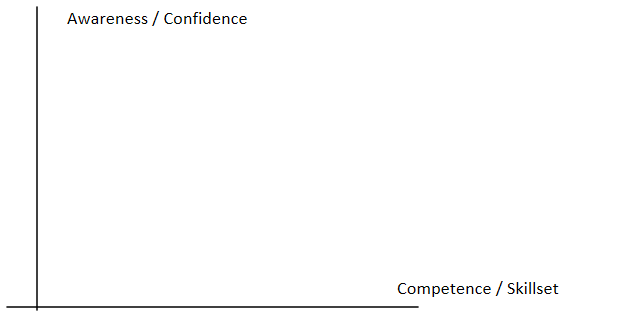Use this Competence/Confidence delegation framework to help your team grow more capable and accountable. And for you to step out of the weeds.
I hear concerns all the time from clients that members of their team aren’t growing fast enough, aren’t taking on enough responsibility, are constantly asking for help. The concern is the team members aren’t growing fast enough to allow the leader to step out of the day-to-day and into a more strategic more visionary role.
“This team member should know this part of their job by now but is still asking for help all the time. I don’t know whether just to tell them what to do or let them figure it out for themselves.”
Feel familiar?
What’s happening here is that the subordinate isn’t taking ownership of his or her work and the leader is having to step in frequently to solve problems, to answer questions, to give direction. Wouldn’t it be great if the person could just understand more of the work and go away and perform it at a high level? To know what and how to delegate effectively? That would free up the leader for highest and best use of their time, and would allow the team member to learn and grow and in their confidence.
So, how do you help without taking over?
Here’s a process for helping your team members begin to grow ownership in their work and for you to know exactly how much direction to give them. This is adapted from the concept of Situational Leadership from people like Ken Blanchard and others. At its core, Situational Leadership simply refers to meeting people where they are and taking them forward to a better, more capable place. Further, this approach allows you to leverage your coaching skills and allows your team members to have agency in their work while they’re growing in their capacity.
Think about an XY axis in which the X axis (the horizontal axis) is a measure of competence or skill set. The Y axis (the vertical axis) is the measure of awareness or confidence.

Based on this model, where would you want people operating? It’s not a trick question: of course, we want them we want them to be in the upper right on the matrix, we want people operating with high competency and high confidence. So how do we get them there?
Imagine you’re giving direction on a new project to a member of your team.
1. Step one is for you to provide the vision for the project and why it’s important. So, you’re providing the What and the Why but not the How. An example: ‘So, could you build a dashboard displaying the key metrics around our new product that we’re about to introduce- in other words, give our management access to the rate at which people are clicking on the page, how long they’re spending there, the conversion rate to download the new product? This will be an important part of measuring how successful we are and give us ideas for how to make adjustments to the product and what products we might want to develop next.’
2. Next, be certain you’ve been clear in your request. Ask the person to repeat back what they heard about the request (‘Just so I’m certain I’ve been clear here, could you feed back to me what you’ve heard? I want to make sure I’ve given you all the parameters of the project.). Depending on what you hear back from the team member, you’ll want to repeat or adjust what you’ve told them to make sure that the project is laid out clearly and accurately. By the way, this works just as well when a team member comes to you with a question about how to approach a project they’re already working on – you need to start with the What and the Why. (‘So let’s talk first about what you want to do accomplish with this project to make sure we’re clear on the goals.’),.
3. Now comes the coaching part. You’ve laid out the What and the Why. Now start coaching them on the How. Ask questions like, ‘What do you think you would do first?’ For the most part, people will have an accurate answer here. They’ll know, based on their experience and their training and their own intuition, a way to get started. If you support their idea, let them know that you agree with the approach to the first step and then ask him or her, ‘What would you do next?’ You can see where this is going; You’re creating an action plan together, but the team member is owning the project, not you.
4. Continue on this path, asking them how they would approach the project step by step until we get to the point where they’re just stuck. This might be because they don’t know what to do next. Or it might be because they take a wrong turn and what they suggest just doesn’t make sense to you. And the answers you get will give you a sense of whether they are lacking a specific skillset, some knowledge of the organization or the process, or whether they are short on confidence. Remember, your goal is to move people to the high, right-hand spot on our chart- high competency AND high confidence- so provide what’s needed in the moment to keep them moving forward.
5. If the person takes a wrong turn, stay in coaching mode: ask them what they think the outcome of this approach would be. Typically, they’ll understand why the approach might not be the best one and they’ll suggest a different way. If they are genuinely stuck, and clearly don’t know what to do next, then it’s OK for you to make a suggestion. Continue until you have a reasonable set of next steps in place.
6. Now it’s time to set milestones. Ask the person, where might you want to set some check-ins on this process? Again, this is theirs to own. If the milestones feel too far apart, make a suggestion to shorten them. But remember, unless the project is so integral to your success it’s important that things never go off track, make this a suggestion and not a directive. In most cases the person will set milestones fairly close in because they want to make sure that they’re staying on the right track.
7. Measure progress on this project allowing the person to report back on their timetable. This helps them build a muscle around accountability. And if they get stuck, follow the same process of coaching them toward what to do next.
A process like this can help your team member take more ownership of their projects, ensure you’re staying out of the weeds and the day-to-day. They’ll be more prepared to take on the next project with less guidance from you. They will feel and express more confidence. And you’re freed up to spend time on higher level thinking and planning. And you will build your coaching skills, which will add to your leadership toolkit. Over time, you’ll find you’re spending less time giving direction and more time listening to all the progress that’s being made.









